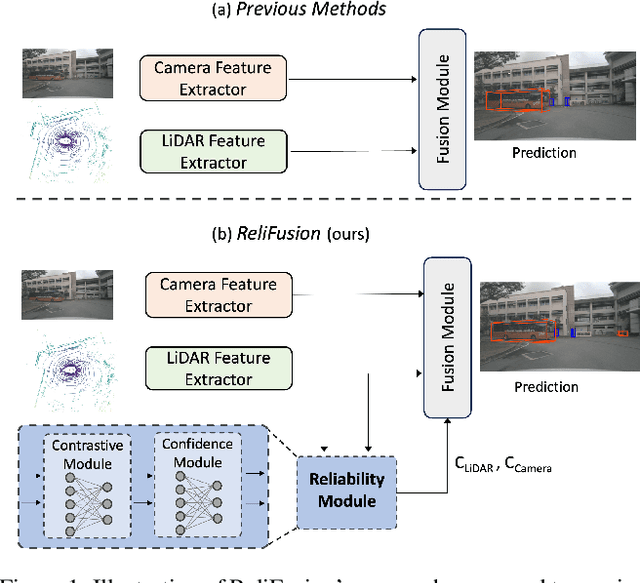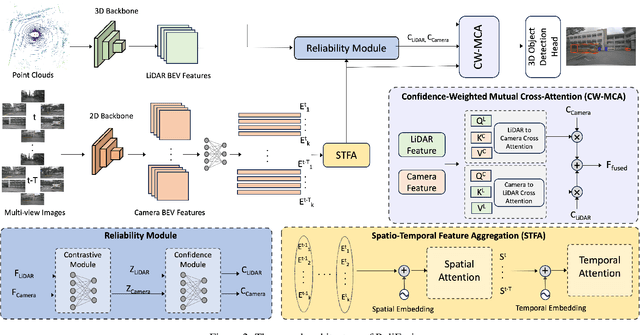WonSook Lee
Reliability-Driven LiDAR-Camera Fusion for Robust 3D Object Detection
Feb 03, 2025



Abstract:Accurate and robust 3D object detection is essential for autonomous driving, where fusing data from sensors like LiDAR and camera enhances detection accuracy. However, sensor malfunctions such as corruption or disconnection can degrade performance, and existing fusion models often struggle to maintain reliability when one modality fails. To address this, we propose ReliFusion, a novel LiDAR-camera fusion framework operating in the bird's-eye view (BEV) space. ReliFusion integrates three key components: the Spatio-Temporal Feature Aggregation (STFA) module, which captures dependencies across frames to stabilize predictions over time; the Reliability module, which assigns confidence scores to quantify the dependability of each modality under challenging conditions; and the Confidence-Weighted Mutual Cross-Attention (CW-MCA) module, which dynamically balances information from LiDAR and camera modalities based on these confidence scores. Experiments on the nuScenes dataset show that ReliFusion significantly outperforms state-of-the-art methods, achieving superior robustness and accuracy in scenarios with limited LiDAR fields of view and severe sensor malfunctions.
Comparison between layer-to-layer network training and conventional network training using Convolutional Neural Networks
Mar 27, 2023
Abstract:Title: Comparison between layer-to-layer network training and conventional network training using Convolutional Neural Networks Abstract: Convolutional neural networks (CNNs) are widely used in various applications due to their effectiveness in extracting features from data. However, the performance of a CNN heavily depends on its architecture and training process. In this study, we propose a layer-to-layer training method and compare its performance with the conventional training method. In the layer-to-layer training approach, we treat a portion of the early layers as a student network and the later layers as a teacher network. During each training step, we incrementally train the student network to learn from the output of the teacher network, and vice versa. We evaluate this approach on a VGG16 network without pre-trained ImageNet weights and a regular CNN model. Our experiments show that the layer-to-layer training method outperforms the conventional training method for both models. Specifically, we achieve higher accuracy on the test set for the VGG16 network and the CNN model using layer-to-layer training compared to the conventional training method. Overall, our study highlights the importance of layer-wise training in CNNs and suggests that layer-to-layer training can be a promising approach for improving the accuracy of CNNs.
A Frequency Domain Constraint for Synthetic X-ray Image Super Resolution
May 14, 2021



Abstract:Synthetic X-ray images can be helpful for image guiding systems and VR simulations. However, it is difficult to produce high-quality arbitrary view synthetic X-ray images in real-time due to limited CT scanning resolution, high computation resource demand or algorithm complexity. Our goal is to generate high-resolution synthetic X-ray images in real-time by upsampling low-resolution im-ages. Reference-based Super Resolution (RefSR) has been well studied in recent years and has been proven to be more powerful than traditional Single Image Su-per-Resolution (SISR). RefSR can produce fine details by utilizing the reference image but it still inevitably generates some artifacts and noise. In this paper, we propose texture transformer super-resolution with frequency domain (TTSR-FD). We introduce frequency domain loss as a constraint to further improve the quality of the RefSR results with fine details and without obvious artifacts. This makes a real-time synthetic X-ray image-guided procedure VR simulation system possible. To the best of our knowledge, this is the first paper utilizing the frequency domain as part of the loss functions in the field of super-resolution. We evaluated TTSR-FD on our synthetic X-ray image dataset and achieved state-of-the-art results.
PS8-Net: A Deep Convolutional Neural Network to Predict the Eight-State Protein Secondary Structure
Sep 22, 2020



Abstract:Protein secondary structure is crucial to creating an information bridge between the primary and tertiary (3D) structures. Precise prediction of eight-state protein secondary structure (PSS) has significantly utilized in the structural and functional analysis of proteins in bioinformatics. Deep learning techniques have been recently applied in this research area and raised the eight-state (Q8) protein secondary structure prediction accuracy remarkably. Nevertheless, from a theoretical standpoint, there are still lots of rooms for improvement, specifically in the eight-state PSS prediction. In this study, we have presented a new deep convolutional neural network (DCNN), namely PS8-Net, to enhance the accuracy of eight-class PSS prediction. The input of this architecture is a carefully constructed feature matrix from the proteins sequence features and profile features. We introduce a new PS8 module in the network, which is applied with skip connection to extracting the long-term inter-dependencies from higher layers, obtaining local contexts in earlier layers, and achieving global information during secondary structure prediction. Our proposed PS8-Net achieves 76.89%, 71.94%, 76.86%, and 75.26% Q8 accuracy respectively on benchmark CullPdb6133, CB513, CASP10, and CASP11 datasets. This architecture enables the efficient processing of local and global interdependencies between amino acids to make an accurate prediction of each class. To the best of our knowledge, PS8-Net experiment results demonstrate that it outperforms all the state-of-the-art methods on the aforementioned benchmark datasets.
3D Ultrasound image segmentation: A Survey
Nov 29, 2016



Abstract:Three-dimensional Ultrasound image segmentation methods are surveyed in this paper. The focus of this report is to investigate applications of these techniques and a review of the original ideas and concepts. Although many two-dimensional image segmentation in the literature have been considered as a three-dimensional approach by mistake but we review them as a three-dimensional technique. We select the studies that have addressed the problem of medical three-dimensional Ultrasound image segmentation utilizing their proposed techniques. The evaluation methods and comparison between them are presented and tabulated in terms of evaluation techniques, interactivity, and robustness.
 Add to Chrome
Add to Chrome Add to Firefox
Add to Firefox Add to Edge
Add to Edge